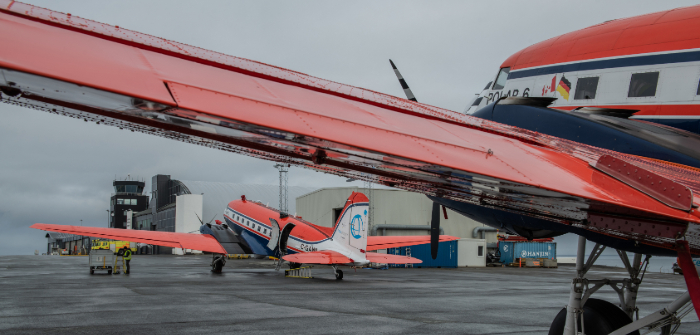Following a five-month mandatory delay due to the coronavirus pandemic, the MOSAiC expedition has announced that on August 30, the two German polar research aircraft Polar 5 and Polar 6 launched from Svalbard to conduct their first aerial survey flights over the Arctic this year. The flights are intended to support the investigation of the atmosphere and sea ice, and supplement the expedition’s already extensive research agenda.
Originally four aerial campaigns were planned during the expedition – two in the spring and two in the summer. But due to the coronavirus pandemic, the spring flights had to be canceled.
“We’re extremely relieved that our two summer campaigns are going to continue despite the coronavirus pandemic, and we’d like to thank both the Government of Norway and the Governor of Svalbard in advance for the great collaboration. Without their support, a research undertaking of this scale simply wouldn’t have been possible under current conditions,” noted atmospheric researcher and campaign leader Dr Andreas Herber from the Alfred Wegener Institute, Helmholtz Centre for Polar and Marine Research (AWI).
Polar 5 and Polar 6 are the first two ‘foreign’ aircraft on Svalbard since the lockdown. Based at Svalbard Airport, they were set to overfly the Central Arctic, with each flight taking between four and five hours. According to the expedition, Polar 5’s research objectives focus on two key scientific questions: how to better understand the processes by which clouds form over the Arctic Ocean, and what part aerosol particles and eddies play in the process. To achieve this, the Polar 5 aircraft is equipped with a diverse range of meteorological instruments, including a lidar system, a photometer and numerous radiometers.
According to the expedition leaders, previous research has shown that clouds are essential to the rapid warming of the Arctic. But modern atmospheric models tend to underestimate clouds’ influence and aren’t yet able to simulate it accurately. Consequently, the team of researchers, drawn from the Alfred Wegener Institute (AWI), the Universities of Leipzig, Bremen and Cologne, and the German Aerospace Center (DLR), hope to conduct large-scale surveys of the air masses over the Arctic Ocean and examine all factors that are relevant for cloud formation in detail.
Insights gained will be used to refine the atmospheric models currently in use. Moreover, the monitoring data will be used in the Collaborative Research Centre “Arctic Amplification (AC)3”, in the context of which a team of experts led by Prof. Manfred Wendisch from the University of Leipzig have been exploring climate changes in the Arctic for the past four years.
Meanwhile, Polar 6 will concentrate on the thickness of sea ice on the Arctic Ocean. The self-declared goal of the MOSAiC research campaign is to document the thickness and surface characteristics of sea ice in Fram Strait and the central Arctic Ocean. To do so, researchers will rely on the EM-Bird – a torpedo-shaped electromagnetic measuring system, which is towed behind and beneath the plane at a height of 15m.
These ice-thickness measurements will form part of the long-term data program IceBird, in the course of which AWI sea-ice physicists have surveyed the Arctic sea ice twice a year for nearly two decades – once at the end of the winter, when the ice reaches its maximum extent, and once in the summer, when it shrinks to its annual minimum.
“This summer, there’s also the exciting question of whether the condition of the floes that were investigated during the MOSAiC expedition stands out in comparison to our long-term data. In other words: whether the ice was generally thinner or thicker than in the past; whether the high summer temperatures had any major effects on it; and whether the rapid drift led to an unusually high number of pressure ridges,” remarked AWI sea-ice physicist and IceBird campaign leader Dr Thomas Krumpen.



